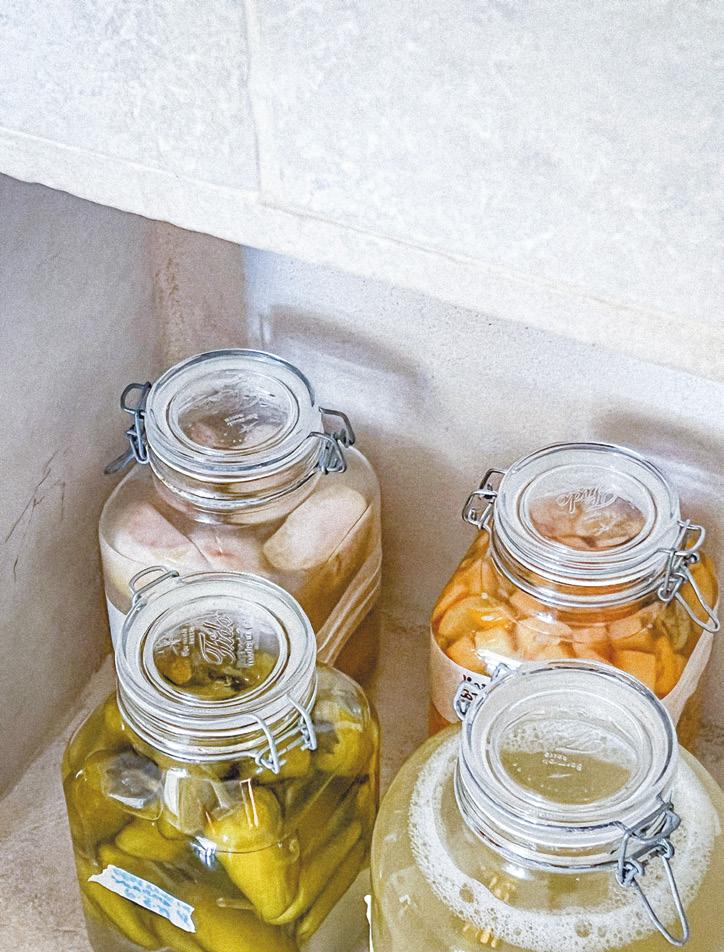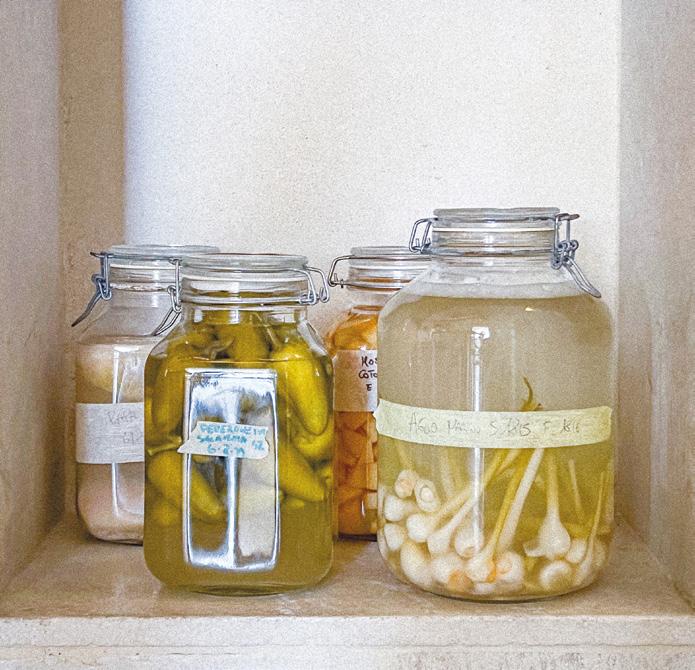
10 minute read
RITI - TRADITIONS
Le stagioni in un barattolo
Seasons in a jar
¬ Gabriella Genisi
LA PREPARAZIONE DELLE CONSERVE È UN RITO MILLENARIO. IL FILO CHE LEGA NONNI E NIPOTI, IL LEGAME ANTICO CHE UNISCE EPOCHE E GENERAZIONI. DAL VINCOTTO DI FICHI ALLA MARMELLATA DI UVA, DALLE MELANZANE SOTTOLIO ALLE OLIVE IN SALAMOIA, DIETRO OGNI RICETTA C’È UNA LITURGIA FAMILIARE. CHE CELEBRA UN SAPORE CAPACE DI FAR VIAGGIARE NEL TEMPO.
The preparation of preserves is an age-old ritual. A thread that unites grandparents and grandchildren, an ancient bond connecting different ages and generations. Every recipe – from fig vincotto to grape jam, from aubergines in oil to olives in brine – has a family liturgy behind it. Celebrating a flavour that will make you travel through time.
C’è una tradizione tipicamente pugliese che mi porto dietro da quando ero bambina e trascorrevo le estati al mare nella villa dei nonni materni: è quella delle conserve preparate in casa, un metodo antico per imprigionare nei barattoli di vetro gli odori e i sapori delle stagioni che lasceranno il posto alle altre. Nonna Angela era la regina delle
conserve, riusciva a mettere sottolio, sottovetro o sotto spirito ogni frutto
o ortaggio raccolto nell’orto, e a me sembrava una bellissima magia. “Prendi la materia prima e la trasformi in altro“, scrive Joanne Harris a proposito della cucina.
Come per ogni tradizione che si rispetti, anche quella delle conserve segue un ordine ben preciso e io amo seguire quello che mi ha insegnato la nonna: comincio dal vincotto di fichi, ingrediente essenziale per preparare cartellate e mostaccioli, tipici dolci natalizi pugliesi, ma ottimo anche sulle cipolle cotte al forno, sulle pittule (palline fritte di pasta lievitata) o per condire i formaggi stagionati. Raccolgo i fichi di due grandi alberi centenari, li lavo, li taglio in quattro e li lascio macerare per qualche giorno in un grande cratere di terracotta. Filtro con un canovaccio di lino il succo raccolto, lo lascio ridurre a fuoco basso per molte ore e lo conservo in bottiglie da mezzo litro.
There is a typical Puglian tradition that I have been following ever since I was a child. I used to spend my summers by the sea at my maternal grandparents’ villa: that was the place where homemade preserves were prepared, an ancient practice collecting the smells and the flavours of an entire season in glass jars. Grandma Angela was the
queen of preserves: she was able to put any fruit or vegetable picked from her garden in oil, under glass or under spirit.
It seemed like magic to me. After all, to quote Joanne Harris, cooking is all about taking raw material and turning it into something else.
Like any self-respecting tradition, the preparation of preserves implies very precise rules to follow, and I love to stick to what my grandmother taught me. I start with fig vincotto, an essential ingredient in the preparation of cartellate and mostaccioli – both typical Puglian Christmas sweets – but also an excellent dressing for roasted onions, pittule (fried balls of leavened dough) and seasoned cheese. I pick the figs from two centuryold trees, wash them, cut them into four pieces and leave them to macerate in a large terracotta pot for a few days. Then I filter the resulting juice with the help of a linen cloth, let it reduce over low heat for several hours, and store it in half-litre bottles.
Continues >
DAGLI ORTI ALLE CUCINE DI BORGO EGNAZIA
FROM THE VEGETABLE GARDENS TO THE KITCHENS OF BORGO EGNAZIA
Passeggiando per Borgo Egnazia vi capiterà di imbattervi in alberi da frutto, piante di fichi d’india e una vasta selezione di erbe aromatiche, custodite nel giardino delle spezie. La maggior parte della frutta e della verdura presente in tutte le cucine di Borgo Egnazia è coltivata all’interno o nei campi limitrofi: le materie prime vegetali prodotte coprono buona parte del fabbisogno annuale dei ristoranti. Ed è così che a Borgo troviamo coltivazioni di broccoli, cavolfiori, cime di rapa, fave e piselli; nei campi di Masseria Cimino, svariati tipi di cicorie, peperoncini, cavoli e bietole, oltre al finocchio, cipolla, barbabietola e menta; a Masseria Le Carrube alberi da frutto come limoni, cachi, albicocche, mele cotogne, melograni, gelsi, fichi e mandorli. Durante l’inverno, le prelibatezze genuine della terra le ritroviamo nelle conserve che i sapienti chef, mescolando tradizione e innovazione, preparano in primavera e in autunno. I prodotti delle stagioni più calde sono conservati in barattoli che, come scrigni segreti, sono pronti a rivelare i loro sapori a distanza di mesi. Nei ristoranti di Borgo si possono gustare, per esempio, funghi o carciofi sottolio, realizzati secondo la tradizione: una volta si facevano bollire le verdure e poi, dopo l’asciugatura, venivano racchiuse in vasetti di olio d’oliva, un prezioso conservante naturale. Oppure si può sperimentare la freschezza dei cibi conservati con la fermentazione in salamoia, in cui si salta il processo di bollitura per preservare le sostanze nutritive. Non fatevi sfuggire l’occasione di pasteggiare davanti al fuoco del camino con le amarene raccolte nel mese di luglio.
Strolling through Borgo Egnazia you will find fruit trees, prickly pear plants and a wide selection of aromatic herbs, treasured in the spice garden. Most of the fruit and vegetables of Borgo Egnazia’s kitchen come from the fields within or surrounding the property, covering a large part of the restaurants’ annual needs. And so at Borgo, you find crops of broccoli, cauliflower, turnip tops, fava beans and peas; in the fields of Masseria Cimino, various types of chicory, chilli peppers, cabbage and chard, as well as fennel, onion, beetroot and mint; in Masseria Le Carrube, fruit trees such as lemons, persimmons, apricots, quinces, pomegranates, mulberries, figs and almonds. During the winter, the genuine local flavours are wisely preserved in the jars prepared by the expert chefs in Spring and Autumn, mixing tradition and innovation. Products of the warmer seasons are stored in jars like secret caskets, ready to reveal their flavours months later. In the restaurants of Borgo, guests can taste, for example, mushrooms or artichokes in oil, made according to tradition: the vegetable is boiled and then, after drying, stored in jars with olive oil, a precious natural preservative. Or they can experience the freshness of foods preserved by fermentation in brine, avoiding the boiling process to preserve nutrients. Do not miss the opportunity to dine in front of the fireplace with the sour cherries harvested in July.
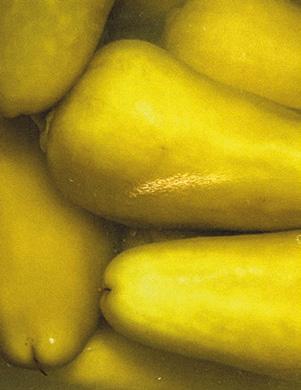
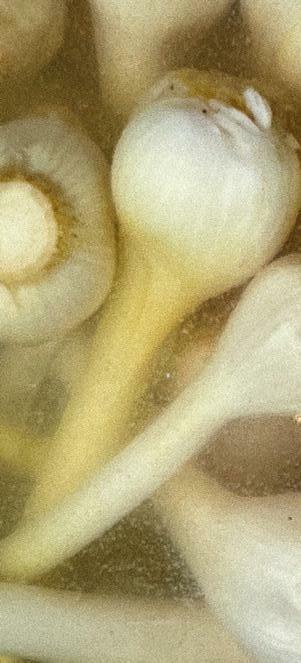
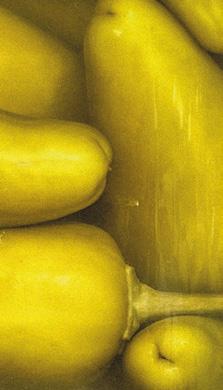
Il secondo passaggio è riservato alla marmellata di uva che servirà per la farcitura dei dolcetti di Natale. Nonna Angela preparava questa marmellata tipicamente pugliese ogni estate, poco prima di chiudere la casa al mare. Ricordo un enorme paiolo di rame pieno di chicchi di uva nera che venivano insaporiti con limoni, mele e cannella e tenuto per ore a cuocere sui fornelli della cucina economica. Si otteneva una melassa scura e dolcissima di cui ero ghiotta. Verso sera nonna Angela riempiva grandi boccacci di vetro, li capovolgeva su una tovaglia a quadretti rossi dove riposavano per tutta la notte e il giorno dopo li sistemava in sala da pranzo, nell’antina in basso del buffet dove sarebbero rimasti fino al 25 novembre, giorno di Santa Caterina.
Era vietatissimo aprire i barattoli prima
di quella data fatidica. La stanza veniva poi chiusa a chiave e la chiave nascosta in posti sempre diversi, ma io riuscivo a trovarla e a scivolare tra tavoli e salottini fino a quel buffet, scrigno di un tesoro. Riuscivo a prendere un barattolo, lo aprivo e munita di un vecchio cucchiaio di stagno mangiavo la marmellata fino a esserne sazia. Di lì a qualche settimana i nonni avrebbero scoperto il misfatto per il quale non sarei mai stata rimproverata. The second step is the preparation of the grape jam that I will use to fill the Christmas sweets. Grandma Angela used to make this typical Puglian jam every year, just before locking her seaside house at the end of the summer. I clearly remember a huge copper cauldron, full of black grapes flavoured with lemons, apples and cinnamon. The cauldron was left on the stove in my grandma’s modest kitchen for hours: the result was a sweet, dark molasses which I was very fond of. Towards evening, Grandma Angela would fill large glass boccacci (a local term for “jars“) and turn them upside-down on a red and white chequered tablecloth, where they were left all night long. The following day she would place them in the lower part of the buffet in the dining room, where they would be kept until 25 November, St. Catherine’s Day.
No one was allowed to open the jars
before that specific date. The room was then locked, and though each time the key was hidden in different places, I always managed to find it and sneak inside to reach the buffet, a real treasure chest. I would get a jar, open it and eat the jam with an old tin spoon until I was full. After few weeks my grandparents would discover the mischief for which I was never scolded.
Continua > Continues >
COME OGNI TRADIZIONE CHE SI RISPETTI, ANCHE QUELLA DELLE CONSERVE SEGUE UN ORDINE BEN PRECISO. GABRIELLA GENISI REPLICA ANCORA OGGI QUELLO CHE LE HA INSEGNATO SUA NONNA.
La preparazione delle conserve è un rito millenario, un legame antico che unisce epoche e generazioni. Da nonni a nipoti, certe abitudini tramandate, certi sapori assaggiati da bambini, restano impressi nella memoria al punto che un barattolo di conserva fatto in casa diventa un prezioso testimone da passare di mano in mano oltre che una macchina del tempo capace di riportarci in un luogo o in un tempo passato.
La suggestione scaturita dalle madeleine assaggiate nell’infanzia da Marcel Proust fu talmente potente da provocare nello scrittore francese l’esigenza di scrivere “La Recherche“. Proust deve aver provato quella stessa vertigine che si prova nelle sere invernali aprendo un barattolo di verdure sottolio o sottaceto. Che siano
melanzane sottilissime o tagliate a misura di dita, o che si tratti di lampascioni fatti sbollentare in acqua e aceto e immersi in olio di oliva extravergine rigorosamente pugliese, ogni volta è un viaggio nei
ricordi e nei sapori. E che dire dei pomodori fatti seccare al sole e delle olive messe in salamoia, delle zucchine tagliate a rondelle, della giardiniera messa a bollire nell’aceto di vino bianco o dei peperoni rossi imbottiti di tonno, capperi e acciughine? Gli aromi di aglio, mentuccia e peperoncino, sapientemente dosati in preziose alchimie, riusciranno a trasmettere grandi emozioni anche ai turisti stranieri che prima di tornare a casa hanno messo in valigia dei souvenir gastronomici al sapore di Puglia. The preparation of preserves is an age-old ritual, an ancient bond connecting different ages and generations. From grandparents to grandchildren, the customs handed down over time and the flavours tasted as children remain in everyone’s memory, to the point that a single jar of home-made preserves becomes a precious legacy to be passed on from one generation to the next, a time-machine that can bring us back in space and time.
The evocative power of the madeleines tasted by Marcel Proust as a child was so strong that it prompted him to write “La Recherche“. Proust must have felt the same giddiness you can experience when opening a jar of vegetables in oil or vinegar on winter evenings. Aubergines
cut into julienne or sticks; lampascioni (tassel hyacinth) first blanched in water and vinegar and then dipped in typical Puglian extra virgin olive oil: whatever you choose, it will always be a journey
into memories and flavours. And what about sun-dried tomatoes, olives in brine, courgettes cut into rounds, giardiniera vegetables boiled in white wine vinegar, red peppers stuffed with tuna, capers and anchovies? The scent of garlic, mint and chili, wisely dosed in a precious alchemy of flavours, will evoke memories and emotions also in those foreign visitors who have brought home a gastronomic souvenir from Puglia.
